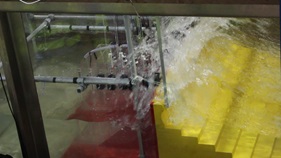
Sea walls and breakwaters are designed to protect people, property and infrastructure from large waves that can occur when a severe storm coincides with a high tide. In order to accurately plan sea defences, a lot of data must be gathered to understand the potential hazards that might occur from the overtopping of these defences for many years to come. Due to the uncertainty in wave overtopping estimates defence construction costs can be higher than necessary as a result of over design to ensure the required level of protection is provided. More accurate defence design and the setting of tolerable hazard thresholds requires site-specific wave overtopping information during storms of varying severity. However, the field experiments used to gather this information can be costly, as well as limited in the amount of data they can provide.
This NERC-funded research project, led by the National Oceanography Centre and HR Wallingford, is taking a low-cost instrument previously used to measure waves in the open ocean, and converting it into an easily relocatable overtopping measurement system – WireWall – that can more confidently assess coastal overtopping hazards, and so help to optimise future sea wall design. The system has been designed to measure wave-by-wave overtopping velocity and volumes using capacitance wire technology. The WireWall system has been tested and refined in HR Wallingford’s flume facility and is now being deployed in the field at Crosby, north of Liverpool.
